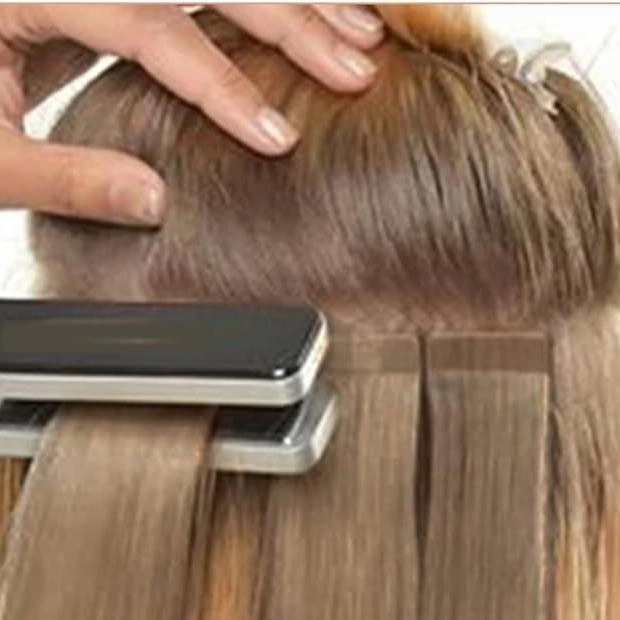If you’ve ever installed or watched someone apply tape-in hair extensions, you’ve probably heard the debate: heating the tape area to make it stick better? Some swear by it, while others warn it’ll ruin your extensions. Let’s break down the noise—starting with real feedback from stylists and clients.
Real Talk from the Community: The Great Heat Debate
First, let’s look at what people are actually saying about heating tape-ins. These comments mirror the back-and-forth we see daily:
The Science: Why Heat Works (and Why It Fails)


So why do people call heating a “mistake”? It’s almost always due to misuse, not the heat itself:
- Too much heat breaks down the adhesive’s molecular structure, turning it sticky or brittle.
- The wrong tools (like high-heat straighteners) can damage both the tape and your natural hair.
To settle the debate, let’s start with how tape-in adhesive works. Most high-quality tape-ins use pressure-sensitive adhesive—a formula designed to bond when pressed firmly, not just when heated. But heat can enhance the bond if done correctly—here’s why:
- Micro-Liquefaction Boosts Grip: Low, controlled heat softens the adhesive slightly (not enough to melt it). This lets the glue “flow” into tiny gaps between your natural hair strands, creating a tighter, more even bond than pressure alone.
- Seals Out Moisture: A properly heated bond forms a tighter seal, which helps repel sweat, oil, or shampoo—common culprits for premature slipping.
✅Do’s: Correct Heating Practices (If You Choose to Heat)
Heating isn’t required for a strong bond—many stylists get perfect results with just firm pressure. But if you want to use heat to boost longevity, follow these rules:
Use the Right Tool
Stick to a low-power hair extension heating iron (100-150 watts) or a mini flat iron set to the lowest heat setting (120–150°F / 49–66°C). Avoid regular straighteners—they get too hot.
Test First
Always test heat on a spare piece of tape (not your actual extensions!). Press the tool to the tape for 2 seconds—if the adhesive stays smooth (not gummy or oozing), it’s safe.
Press, Don’t Hold
After placing the extension, hold the heated tool lightly on the tape area for 2–3 seconds max. Use gentle pressure—no need to clamp hard. Move the tool in small, quick motions to evenly distribute heat.
Follow with Pressure
After heating, press the tape with your fingers (or a hair extension plier) for 5 seconds. This locks the softened adhesive into place.
⛔Don’ts: Mistakes That Ruin Your Tape & Hair
These are the errors that turn heating into a disaster—avoid them at all costs:
Don’t Overheat
Never use heat above 180°F (82°C). Temperatures higher than this will melt the adhesive, making it useless.
Don’t Hold the Tool Too Long
Holding heat on the tape for 5+ seconds will break down the adhesive. Quick, light touches are key.
Don’t Heat the Hair, Just the Tape
Focus the tool only on the tape strip—not the extension hair or your natural hair. Heating the hair can cause damage or frizz.
Don’t Skip Pressure
Heat alone won’t bond the tape. Always follow heating with firm, even pressure—this is what finalizes the bond.
Final Verdict: Heat Isn’t a Must—But Proper Technique Is
Heating tape-in extensions is neither a “must” nor a “misconception”—it’s a tool that works when used correctly. For most people (especially beginners), skipping heat and using firm pressure with clean, dry hair will give you a long-lasting bond (4–8 weeks, depending on care).
If you do choose to heat, remember: low temperature + quick pressure = success. High heat + long holds = wasted extensions.
Contact Us
-
Understanding Hair Extension Color Numbers
Choosing the right hair extension shade can be tricky—especially when you see color codes like #3/8/22 or #18P613. At first […]
-
How to Find the Best Natural Light for Hair Color Photos (So We Can Match Your Shade Perfectly!)
If you’ve ever sent a hair photo thinking, “This is my exact color!” only to get a extensions shade that […]
-
Why Do Your Hair Extensions Break?
Dear customers, we understand how frustrating it can be to wear your new extensions with such great anticipation, only to […]